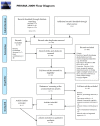Understanding the Effects of Transcranial Electrical Stimulation in Numerical Cognition: A Systematic Review for Clinical Translation
- PMID: 35456176
- PMCID: PMC9032363
- DOI: 10.3390/jcm11082082
Understanding the Effects of Transcranial Electrical Stimulation in Numerical Cognition: A Systematic Review for Clinical Translation
Abstract
Atypical development of numerical cognition (dyscalculia) may increase the onset of neuropsychiatric symptoms, especially when untreated, and it may have long-term detrimental social consequences. However, evidence-based treatments are still lacking. Despite plenty of studies investigating the effects of transcranial electrical stimulation (tES) on numerical cognition, a systematized synthesis of results is still lacking. In the present systematic review (PROSPERO ID: CRD42021271139), we found that the majority of reports (20 out of 26) showed the effectiveness of tES in improving both number (80%) and arithmetic (76%) processing. In particular, anodal tDCS (regardless of lateralization) over parietal regions, bilateral tDCS (regardless of polarity/lateralization) over frontal regions, and tRNS (regardless of brain regions) strongly enhance number processing. While bilateral tDCS and tRNS over parietal and frontal regions and left anodal tDCS over frontal regions consistently improve arithmetic skills. In addition, tACS seems to be more effective than tDCS at ameliorating arithmetic learning. Despite the variability of methods and paucity of clinical studies, tES seems to be a promising brain-based treatment to enhance numerical cognition. Recommendations for clinical translation, future directions, and limitations are outlined.
Keywords: arithmetic processing; cognitive training; dyscalculia; interventions; non-invasive brain stimulation; number processing.
Conflict of interest statement
The authors declare no conflict of interest.
Figures




References
-
- Parsons S., Bynner J. Does Numeracy Matter More. NRDC; London, UK: 2006. pp. 1–44.
Publication types
LinkOut - more resources
Full Text Sources

